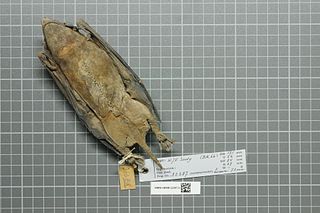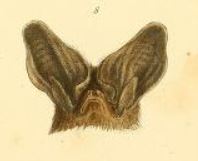 W
WThe black-footed cat, also called the small-spotted cat, is the smallest wild cat in Africa, having a head-and-body length of 35–52 cm (14–20 in). Despite its name, only the soles of its feet are black or dark brown. With its bold small spots and stripes on the tawny fur, it is well camouflaged, especially on moonlit nights. It bears black streaks running from the corners of the eyes along the cheeks, and its banded tail has a black tip.
 W
WThe boodie, also known as the burrowing bettong, or Lesueur's rat-kangaroo, is a small marsupial. Its population is an example of the effects of introduced animals on Australian fauna and ecosystems. Once the most common macropodiform mammal on the whole continent, the boodie now only lives on off-lying islands and in a newly introduced population on the mainland at Shark Bay. This animal, first collected during an 1817 French expedition of the west coast, was named after Charles Lesueur, an artist and naturalist who accompanied a previous French expedition.
 W
WThe brown pipistrelle is a species of vesper bat in the family Vespertilionidae. It is found in Indonesia and Malaysia.
 W
WBurchell's zebra is a southern subspecies of the plains zebra. It is named after the British explorer and naturalist William John Burchell. Common names include the bontequagga, Damaraland zebra, and Zululand zebra. Burchell's zebra is the only subspecies of zebra which may be legally farmed for human consumption.
 W
WThe common tsessebe or sassaby is one of six subspecies of African antelope Damaliscus lunatus of the genus Damaliscus and subfamily Alcelaphinae in the family Bovidae. It is most closely related to the topi, korrigum, coastal topi and tiang, and the bangweulu tsessebe and bontebok in the same genus. Tsessebe are found primarily in Angola, Zambia, Namibia, Botswana, Zimbabwe, Eswatini (Swaziland), and South Africa. Tsessebe are the fastest antelope in Africa and can run at speeds over 90 km/h.
 W
WThe East Siberian brown bear (Ursus arctos collaris) is a population or subspecies of brown bear which ranges from eastern Siberia, beginning at the Yenisei river, north to the Arctic Circle, as far as Trans-Baikaliya, the Stanovoy Range, the Lena River, Kolyma and generally throughout Yakutia and the Altai Mountains. The subspecies is also present in northern Mongolia.
 W
WThe hairless bat, also called the naked bulldog bat and greater naked bat, is a species of bat in the family Molossidae. The generic name Cheiromeles comes from the Greek word cheir and the species name is derived from the Latin torques.
 W
WHardwicke's woolly bat is a species of vesper bat in the family Vespertilionidae.
 W
WHippopotamus major or the giant European hippo is an extinct species of hippopotamus found in Pleistocene fossil sites in Europe and Great Britain. With an estimated mass of 4000 kg or more, H. major was on average larger than the modern Hippopotamus amphibius.
 W
WThe hourglass dolphin is a small dolphin in the family Delphinidae that inhabits offshore Antarctic and sub-Antarctic waters. It is commonly seen from ships crossing the Drake Passage, but has a circumpolar distribution.
 W
WThe large-footed bat, large-footed mouse-eared bat, or large-footed myotis is a species of vesper bat. It can be found in the following countries: Australia, Indonesia, Malaysia, Papua New Guinea, Singapore, Solomon Islands, Taiwan, Vanuatu, and possibly Vietnam.
 W
WThe Mexican free-tailed bat or Brazilian free-tailed bat is a medium-sized bat native to the Americas, regarded as one of the most abundant mammals in North America. Its proclivity towards roosting in huge numbers at relatively few locations makes it vulnerable to habitat destruction in spite of its abundance. It has been claimed to have the fastest horizontal speed of any animal, reaching top ground speeds over 100 mph (161 km/h); its actual air speed has not been measured. The Texas Legislature designated the Mexican free-tailed bat the state mammal (flying) in 1995.
 W
WThe prehensile-tailed hutia is a species of rodent in the family Capromyidae endemic to Cuba. It is an arboreal foliovore, found in both primary and secondary forest. Its karyotype has 2n = 34 and FN = 54-56.
 W
WThe slender squirrel is a species of rodent in the family Sciuridae. It is arboreal and found in Indonesia, Singapore, Malaysia, and Thailand. The body is brown on the upper parts and light grey on the underparts. The body measures about 13–16 cm, with a slightly shorter slender tail. It feeds on soft bark, fruits and insects.
 W
WThe Sulawesi bear cuscus or Sulawesi bear phalanger is a species of arboreal marsupial in the family Phalangeridae endemic to Sulawesi and nearby islands in Indonesia. It lives in tropical moist lowland forest at elevations up to 600 m and is diurnal, folivorous and often found in pairs. A. ursinus is threatened by hunting, collection for the pet trade and deforestation.
 W
WThe tropical big-eared brown bat, is a bat species from South America. It is found in Bolivia, Peru, Argentina, Brazil and Paraguay
 W
WThe Western barred bandicoot, also known as the Marl, is a small species of bandicoot found in Australia.
 W
WThe whiskered flying squirrel is a species of flying squirrel. It is found in Indonesia and Malaysia.